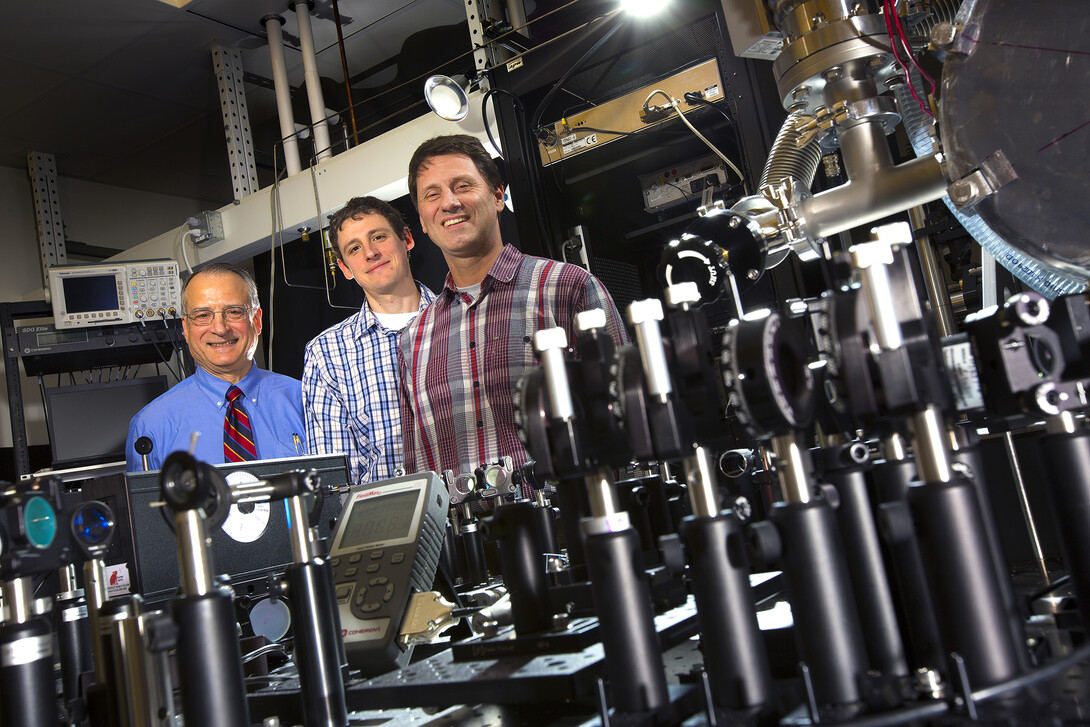
Observing what happens in one-trillionth of a second—the opening moves in photosynthesis, for example—requires precision and extremely fast devices. UNL physicists are expanding their experimental and theoretical arsenals to help reveal how light interacts with atoms, molecules and nanostructures.
Their discoveries could one day lead to much faster computers, more efficient solar technology and other enhanced light-based technologies.
UNL is building new devices over the next two years that will enhance UNL’s capabilities for observing ultrafast processes.
“This will really build up the infrastructure at UNL to produce new science,” said Anthony Starace, George Holmes University Professor of Physics. “Ultrafast science is the next step in humanity’s ability to understand nature and ultimately control these processes.”
Thirteen UNL physicists and engineers are collaborating with colleagues at Kansas State University and the University of Kansas on the Nebraska-Kansas Consortium, a partnership to expand all three universities’ capacity to study atomic, molecular and optical physics. The tools they develop could have applications in laser technology, solar energy capture, nanotechnology and optoelectronics, the combination of electronics with light.
The National Science Foundation’s Experimental Program to Stimulate Competitive Research, or EPSCoR, funds the consortium with a three-year, nearly $6 million award, of which Nebraska received nearly $3 million. It’s one of three science and engineering consortia funded by the program nationwide.
The consortium is taking two approaches to observe and control ultrafast processes. The first approach is based on the premise of stop action made famous by 1925 UNL alumnus Harold Edgerton and his iconic image of a bullet piercing an apple.
Today, scientists use electron and laser pulses to capture ultrafast processes in images recreated from electron scattering. This approach is helping physicists understand and, ultimately, control the molecular changes that occur when light strikes molecules, during photosynthesis or human vision, for example.
Some processes happen too fast to capture with current technology. To overcome these limitations, UNL physicists Martin Centurion and Matthias Fuchs are designing and building a new source of electron pulses using high-powered lasers.
The souped-up equipment may help elucidate ultrafast transformations in solids that, like Edgerton’s apples, are destroyed by the experiment. This breakthrough would open new avenues in materials science research.
When completed, this new equipment is expected to be the first to have achieved this level of detail, Centurion said.
The second approach uses light pulses to overcome the relatively slow speed of electronics, which is based on the movement of electrons. Light photons travel significantly faster than electrons, so merging light with electrons near specially created nanostructures may result in much faster computers and other electronic devices.
The EPSCoR grant enables collaboration between researchers who can make nanostructures and those who are experts at controlling short pulses of laser light and electrons.
The consortium includes 30 physicists, chemists, computer scientists and electrical engineers at UNL, KSU and KU. Starace and Centurion as well as physicist Herman Batelaan lead UNL’s consortium participation. Overall project leaders are Fred Choobineh, UNL electrical engineering professor and director of Nebraska EPSCoR, and Kristin Bowman-James, KU chemistry professor and director of Kansas EPSCoR.
The consortium also will provide educational and outreach activities to broaden the participation of small Nebraska and Kansas colleges in research, including students underrepresented in science and engineering. Other activities include expanding student participation in UNL’s annual Undergraduate Women in Physical Sciences conference and hosting high school teachers at summer workshops.







